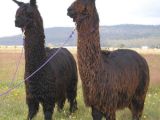1. Life in the Andes would be impossible without them. When a house is built on the Andes plateaus, people use to immure at its foundation a new born llama. For thousands of years, llamas have been used for meat and burden transport, while its other domesticated relative, alpaca, delivered the finest wool for making blankets and ponchos (traditional mantles). A llama can transport up to 20 kg (44 pounds) of cargo.
2. Andean plateaus are of two types: wet paramos, between 3,800-4,600 m (12,600-15,300 ft) and dry punas, over 4,000 m (13,300 ft). Llama and alpacas thrive in the punas. A puna is characterized by low rainfall, extreme winds, powerful sunlight, rare and purified air. As an adaptation to these conditions, llamas and alpacas have dense and soft wool, thick skin, oval (not rounded) blood red cells.
3. Llamas and alpacas seem to have been domesticated in the area of the Lake Junin (Peru), around 2,500-1,750 BC.
4. Llamas were often sacrificed by Natives during their ceremonies, and even today the Indian fathers, with the occasion of the birth of a boy in their family, kill llamas or alpacas.
In the syncretic religion of the Andes, inside the churches, next to statues of the Catholic saints, you can see terracotta statues of llamas. During the Inca period, there were llama caravans made of 25,000 animals.
5. Llamas and alpacas are raised in conditions of semi-liberty. During the night, the animals are sheltered in open pens, surrounded by walls that keep some of the day's heat. Next morning, the animals go by themselves to graze and return to the pen at sunset. Through selection, people achieved alpacas with the hair long to the ground.
Cattle, horses or sheep could not adapt to puna conditions, with high temperature differences between day and night and poor food conditions.
6. Llama can have a hight of 1.3 m (4.3 ft), a length of 2 m (6.6 ft) and weight of 450 pounds (204 kg). Gestation lasts 11 months and the only offspring is raised for 15 months.
7. The Andean Indians use a system of knots made on the llama coat to transmit various messages and information.
8. One alpaca can deliver 3 kg (7 pounds) of wool at every two years. Alpaca is smaller than llama; it can be just 90 cm (3 ft) tall. 3 million individuals are found in Peru and about 50,000 in Bolivia, but attempts to colonize this animal, possessing the most expensive wool in the world, have failed so far in other areas.
9. Llamas and alpacas are closely related to camels. Like camels, they can spit as a method of establishing hierarchy, especially during the feeding time, as a way of disciplining lower-ranked individuals in the herd. Females also spit to chase away insistent males. The second type of spit is less smelly.

 14 DAY TRIAL //
14 DAY TRIAL // 
